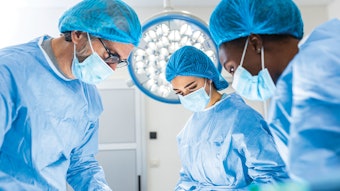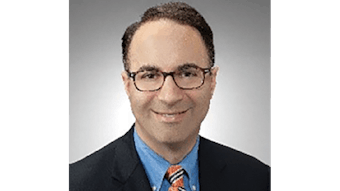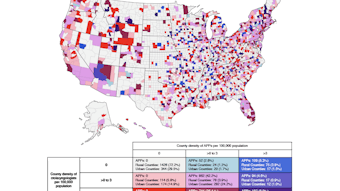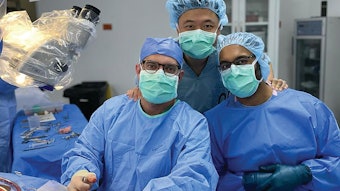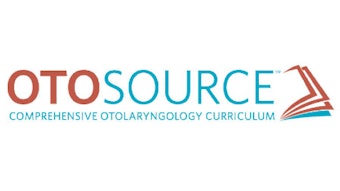OUT OF COMMITTEE: Rhinology and Paranasal Sinus Disease | Non-Procedural Management of COVID Patients: COVID’s Sinonasal Sequela and How to Provide Help for Patients in Need
Throughout the course of this pandemic, we have gone from fear of the unknown to a deeper understanding of the disease, though many questions about the long-term sequela of this infectious disease loom large.
Christie A. Barnes, MD, committee member

What Is the Experience of Colleagues Nationwide?
I wanted to understand if my experience with neurological sequela in post-COVID patients was typical of what otolaryngologists and rhinologists around the country were seeing. I contacted colleagues all over the United States. Unsurprisingly, the most common complaint following COVID infection seen in ENT clinics is smell and taste disturbance. The providers I spoke to reported smell and taste disturbances to be 20%-70% more common than pre-COVID levels. Several reported that hyposmia or anosmia have become the minority of smell consult patients in the last year—unsurprising since media coverage has drawn attention to this symptom and because of its self-limiting nature. However, they have been seeing increases in parosmia/phantosmia complaints. Additionally, our colleagues nationwide report an increase in the number of “sinus headache” and “sinusitis symptoms” that appear to be temporally linked to a COVID infection. Often, these headaches are accompanied by a feeling of depressed functioning or cloudy feeling (brain fog), and there appears to be no consistent location for this type of headache. So, what do we know about the chronic neurologic sequelae after COVID?
Long COVID Syndrome Neurologic Sequela
Neurological complaints are not uncommon in post-COVID syndrome and often include dysgeusia, hyposmia, and headaches.1 Headache in a recent meta-analysis is found in 8%-15% of patient in the first six months after infection.2 Neurocognitive symptoms of brain fog include complaints of difficulty processing, short-term memory issues, and challenges with focusing.
A recent review describes the possible pathophysiology as one linked to the high affinity of SARS-CoV-2 for human angiotensin-converting enzyme (ACE2) receptor.1 Noted is that “this receptor is also expressed in neurons and glial cells, which could explain the reported neurological manifestations, such as olfactory neuropathy (anosmia), peripheral neuropathy and brain disorders.”3 Furthermore, postmortem studies have revealed the presence of SARS-CoV-2 viral particles in the olfactory bulb, cerebral spinal fluid, and higher cortical centers.3 It is also thought that the viral infection potentially leads to central cytokine storm, resulting in the symptoms of headache and potentially brain fog, though further investigation is needed to fully understand this and the potential overlap with neuropsychological symptoms.2
Several mechanisms have been proposed for olfactory disturbances, and currently it is felt that these mechanisms may overlap. These mechanisms include conductive obstruction due to edema in the olfactory cleft, direct injury to the olfactory epithelium, and potentially retrograde axonal transport to the olfactory bulb and higher cortical centers along the olfaction pathway.4 Surveys of patients with hyposmia reveal that the majority of patients regain their sense of smell in the first four weeks of infection and more still in the first year. There is a small percentage of patients who in the first years of the pandemic have not recovered olfactory function. Post-COVID olfactory perception distortions (parosmias and phantosmias) have not been vigorously studied or reported.
Recommendations for Olfactory Dysfunction (OD)
For patients complaining of OD following COVID-19 infection, a thorough history is paramount. A recent Bulletin article by Zara M. Patel, MD, provides an excellent review of OD: “How to Diagnose and Manage the Patient with Olfactory Loss” (https://bulletin.entnet.org/home/article/22197344/from-the-education-committees-how-to-diagnose-and-manage-the-patient-with-olfactory-loss).
Your physical exam should include nasal endoscopy. Imaging for post-COVID OD is not generally indicated unless finding on endoscopy or history suggests any other underlying condition, such as sinus disease (CT scan) or neurologic disease or malignancy (MRI). Validated olfactory testing is helpful in these patients. The disposable, validated, and quantifiable characteristics of the University of Pennsylvania Smell Identification Test (UPSIT) make it very useful in the clinical setting.
Treatments other than olfactory training do not have robust data to support them.4 Oral and topical steroids in isolated post-COVID OD have not been found to be as helpful as we would have hoped, unless the patient has concomitant sinus disease.5
Many of these patients with OD will come to you for advice, and any discussion on OD should include counseling on safety, quality of life issues, and prognostic factors. Reassurance that the majority of these patients will regain their smell and taste within the first year after infection is often helpful for patients who are distressed by this symptom. Counseling on fire and gas or propane leak detectors, the dangers of spoiled foods, and the social impacts of personal hygiene as their smell recovers provides valuable information to patients. Additionally, for those who suffer concomitant taste disturbances, counseling should include a discussion on judicious use of salt and sugar and instead substitution with spices, such as peppers and hot sauces. Patients with diminished taste may find varying textures of food can improve the enjoyment of mealtime.
Considerations for Parosmia and Phantosmia Patients
Patient with parosmia describe odorants smelling different than they remember or like something else entirely (i.e., peach smells like pond scum). Phantosmia patients will report an odor(s) that pervades their environment and often bleeds into the taste of their food in the absence of an odorant (i.e., everything smells of dirty gym clothes). Often, it is the unpleasant tastes and smells that bring patients in for an evaluation. Phantosmia patients, in particular, often go to great lengths to investigate the source of the smell and will report tearing up carpet, calling plumbers to investigate, and scrubbing their whole house with cleaner. The natural evolution of post-COVID olfactory perceptual distortions is unknown and needs to be further evaluated. These perceptual distortions are often distressing and can have a negative impact on the patient’s quality of life. Olfactory testing and potentially imaging are often indicated in these patients, however ruling out another underlying cause is crucial. Assessment of these patients by a rhinologist may be warranted to ascertain if the distortion is central or peripheral and unilateral or bilateral. Referral to psychology should be considered as well for further evaluation if indicated.4 Further studies need to be done to further understand these distortions in this setting.
Post-COVID Headache and Brain Fog
As with OD, history and physical exam are crucial. It is imperative to rule out sinonasal disease in patients with headache. Characteristics of the headache may point to etiology, and in the setting of a normal physical exam and normal endoscopic exam, may be the only clue to underlying disease. Careful consideration for other disease, such as primary headache disorder, tumor, secondary headaches such as sleep apnea related, and TMJ arthralgia, can be teased from the history.
Consultation with neurology is crucial for these patients as they can further assist with diagnosis and treatment. Many of my neurology colleagues relate that brain fog remains an issue for which there is little data. It has been postulated that the mechanism of this symptom is a chronic low-grade inflammatory state. My colleagues note that steroids, CoQ10, and other therapies, however, have been tried without any improvement of symptoms. From a practical clinical standpoint and from discussions with our neuropsychology colleagues, Elizabeth Hartman, MD, relates that post-COVID patients have several factors that contribute to brain fog, and she tries to focus on the treatable ones. Her conversations with patients focus on prioritizing restful sleep and treating insomnia or other sleep disorders, such as sleep apnea. She and her colleagues look for other contributors (thyroid, metabolic issues, such as B vitamin deficiencies, medication side effects, potential autonomic dysfunction, such as POTS, and rarely ruling out stroke/other more serious COVID-19 complications). She emphasizes helping patients start a graduated exercise program to improve exercise tolerance often with help of a physical therapist for a post-COVID program. Dr. Hartman also notes the importance of optimizing behavioral health, such as underlying or new depression and anxiety that have been exacerbated by not only illness but isolation, pandemic stressors, financial stressors, etc. Most importantly, she recommends trying to help the patient avoid or break out of a cycle of not feeling well and therefore becoming more inactive, getting more isolated, and then feeling worse.
Tailored treatments and rehabilitation are important for the recovery of patients with neurological sequela of COVID-19 infection. Often, these complex patients require the assistance of a multidisciplinary team of specialists. The otolaryngologist is often on the front lines encountering patients with these complaints. Treatments and understanding of the disease process are evolving, and we still have much to learn.
Special thanks to Elizabeth Hartman, MD, Associate Professor, Neurology Clinic Director, and Division Chief of Headache Neurology, Department of Neurological Sciences at the University of Nebraska Medical Center and many of my colleagues from the Department of Neurological Services who answered my many questions and provided expertise for this article.
References:
- Sharifian-Dorche M, Huot P, Osherov M, Wen D, Saveriano A, Giacomini PS. Neurological complications of coronavirus infection; a comparative review and lessons learned during the COVID-19 pandemic. J Neurol Sci. 2020;417:117085. doi:10.1016/j.jns.2020.117085
- Fernández-de-las-Peñas C, Navarro-Santana M, Gómez-Mayordomo V, et al. Headache as an acute and post-COVID-19 symptom in COVID-19 survivors: a meta-analysis of the current literature. Eur J Neurol. 2021; 28: 3820-3825. https://doi.org/10.1111/ene.15040
- Camargo-Martínez W, Lozada-Martínez I, Escobar-Collazos A, et al. Post-COVID 19 neurological syndrome: implications for sequelae’s treatment. J Clin Neurosci. 2021;88:219-225. doi:10.1016/j.jocn.2021.04.001
- Patel ZM, Holbrook EH, Turner JH, et al. International consensus statement on allergy and rhinology: olfaction. Int Forum Allergy Rhinol. 2022;1-352. https://doi.org/10.1002/alr.22929
- Abdelrahman AA, Ayman AM, Rasha AE, et al. Corticosteroid nasal spray for recovery of smell sensation in COVID-19 patients: a randomized controlled trial. Am J Otolaryngol. 2021;42(2):102884. doi: 10.1016/j.amjoto.2020.102884
